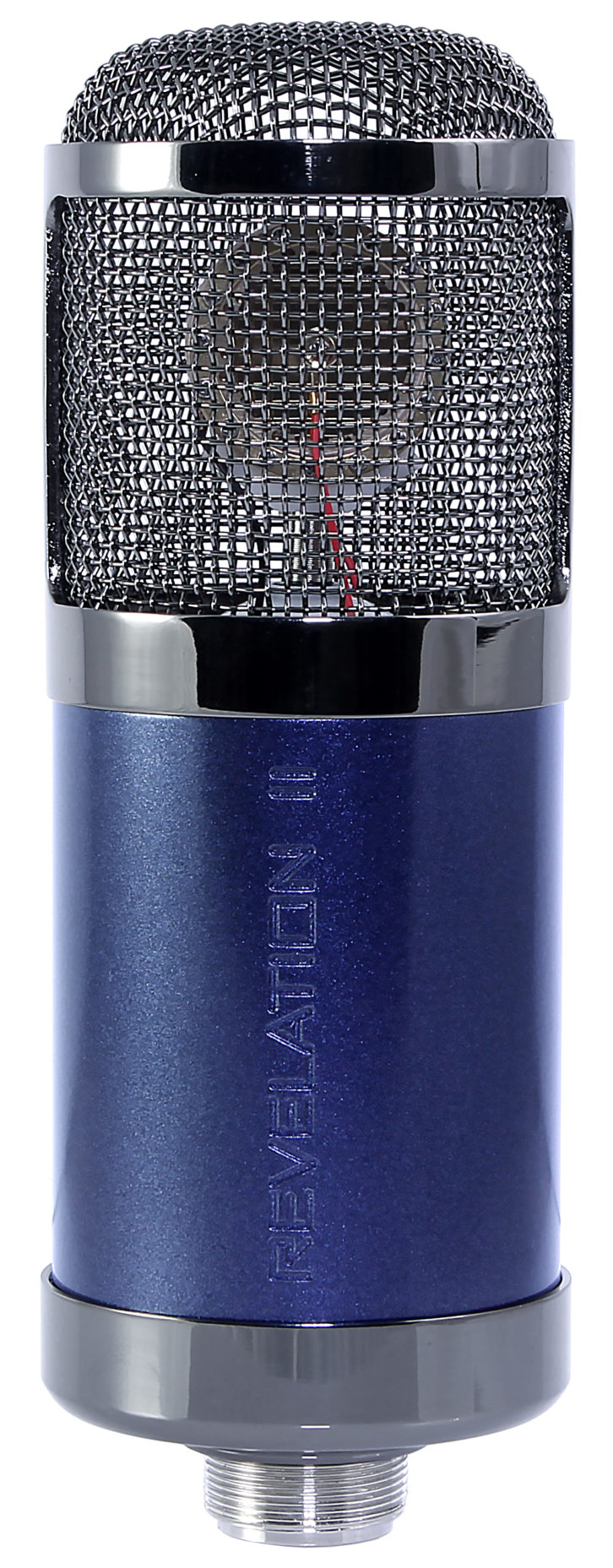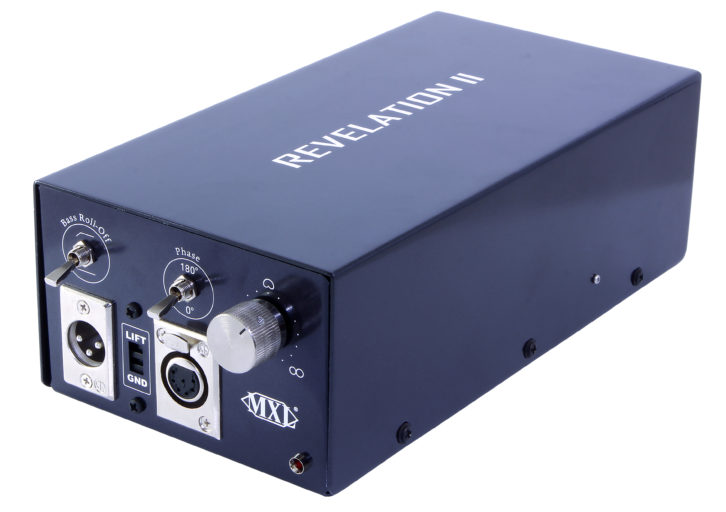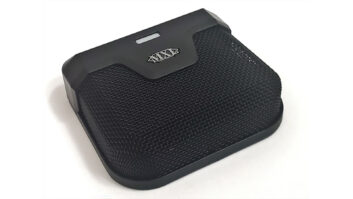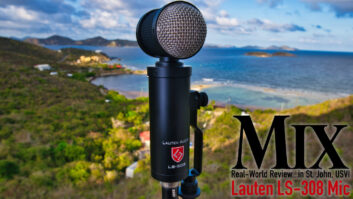
The Revelation II from MXL is a large-diaphragm tube condenser microphone designed for vocal and instrument applications. Its lineage traces back to one of MXL’s most successful products, the Revelation, but the Revelation II takes advantage of the latest manufacturing technologies to bring its price down to a point accessible to pro and project studios alike.
Intended to capture the warmth of a classic tube microphone, the Revelation II utilizes a 6-micron, gold-sputtered, dual capsule with a diameter of approximately 1.25 inches. A continuously variable pattern control on the external power supply allows the Revelation II to produce in-between pattern settings such as wide cardioid and super-cardioid, in addition to the standard three (cardioid, omni and figure-8). Amplification circuitry is based around an EF86 pentode, and the output is transformer-balanced.
The Revelation II is packaged in an aluminum briefcase with a nice set of accessories, including the external power supply, 7-pin Mogami cable for connecting the mic to the power supply, standard 3-pin Mogami cable for audio output, shockmount with spare elastic bands, and a cleaning cloth. No hard mount is provided, as befits a microphone of this size and weight. Photos of the Revelation II don’t do it justice. The body paint and black chrome accents look pretty darn good.
Power Up
The power supply for the Revelation II is a sizable brick with some heft to it. Controls on the power supply include the pattern control, low-frequency rolloff switch (–12 dB/octave @ 125 Hz), a phase reverse switch and a ground lift. Power supply input voltage can be switched between 110 or 220 VAC, and the mic ships with a “Please Check Voltage” notice taped across the IEC receptacle. MXL advises not to hot-plug the microphone, and I concur, having blown up a power supply or two by doing so in my distant past.
My first sessions employed the MXL Revelation II on drums, starting with outside kick drum.
To avoid overloading the input of the mic pre, I turned on the mic’s pad, which (unlike the remainder of controls) is located on the microphone body. Positioning the mic approximately 16 inches from the front kick head produced a classic low-mid knock that you expect from a large-diaphragm condenser outside a kick, but yielded a bit less low end than I anticipated; I was able to get that from the close mic.
Next, I set the Revelation II on a boom stand approximately five feet high, centered over the kick drum and angled slightly toward the snare. The pattern control was set two dots to the left of cardioid (yielding a wide cardioid pattern), bass rolloff was turned off and the mic was connected to a Drawmer 1969 preamp/compressor set to compress a few dB.
My first reaction was, “Wow, this mic loves toms”—which were captured with a wonderful balance between attack from the stick and the tone and resonance of the shells. Kick drum, however, was rather boomy and almost dominated the kit. Turning on the rolloff removed a bit too much of the bottom end, and gave the subjective impression that the hi-hat was louder (it wasn’t). I opted to disengage the rolloff and instead used a 50 Hz, 6 dB/octave filter in the DAW, which tamed the kick drum without compromising the sound of the toms.
Hearing the way toms sounded when the Revelation II was used overhead inspired me to use it to record a floor tom overdub, where the part was kind of a jungle rhythm.
For this recording the Revelation II was plugged into a Great River MP2-NV, placed just above the rim of the floor tom and angled toward the center of the head. It killed. The tom was big, fat and round with a perfect balance of attack and girth. I kind of wished I had another Revelation II (or two) to close-mic all of the toms—though placement would be difficult due to the size of the mic/shockmount combination. Speaking of placement, in spite of the fact that the mic weighs in at two pounds, the pivot on the shockmount didn’t slip once, which cannot be taken for granted.
Used as a room microphone for the same drum kit, the bottom end of the kick drum overwhelmed the kit; turning on the rolloff at the power supply restored order and balance.

Bring on the Voice and Guitar
Using the Revelation II to record vocals proved to be most interesting. I’m not sure I’ve ever used a microphone that has a phase reverse switch on its power supply. Most of us are accustomed to using phase reverse (“polarity reverse,” if you want to be picky) on the mic preamp or in software—like when comparing the phase between the kick in and kick out mics mentioned earlier. However, there’s a valuable application for that switch when recording vocals.
If a singer hears his or her voice through headphones, and it is out of phase with the acoustic transmission of the voice through the air (and/or the mechanical transmission of the voice via bone conduction), the resulting loss of low-mids in the cans is substantial. Locating the phase at the power supply provides a singer with the ability to instantly compare the difference between the mic being in-phase or out-of-phase with the natural sound of their voice, and the perceived restoration of low-mids subsequent to flipping the phase switch can be profound.
Listening in the control room, you’ll hear no difference on a lead vocal track whether the phase is reversed or not—but the singer’s headphone monitoring experience can be vastly different. If reversing the phase allows them to hear their voice more clearly in the ‘cans (and sometimes it does), you’ll get a better performance.
When a singer is working really close, the Revelation II can get a bit thick in the lower-midrange. As a result, I preferred using the rolloff when recording vocals, which allows a singer to get in very close to produce an intimate sound, while maintaining clarity and tight low-mids. The Revelation II’s grille is constructed from a single layer of mesh; this, combined with the extended LF response, means you’ll need to use a pop filter when recording vocals; then again, you should be using one anyway.
The Revelation II also proved to be a good choice for recording acoustic guitar. I set the mic to cardioid and placed it about 10 inches from the area where the neck meets the body, with the capsule turned slightly toward the sound hole. The resulting sound was gorgeous: very “hi-fi,” bright and articulate without being harsh, with a clear representation of the pick on the strings when the player strummed. It was a little big in the bottom without the rolloff, which was fine for a song that featured only guitar and vocal, but I think I’d use the rolloff if the track was to be part of a busy mix.
A bit of care should be exercised when changing patterns on the Revelation II’s power supply. It can take as long as 15 to 20 seconds for the power supply to stabilize when changing from one pattern to another. During that time some thumping noises can be produced, so it would be wise to mute your monitors.
As you’d expect, setting the microphone to omni reduces the proximity effect heard in cardioid and figure-8, but I also felt like the omni pattern exhibited a subtle difference in the upper midrange, adding a little bit of “air.” Also, I felt that the settings in-between cardioid and omni were a bit darker than straight cardioid. Call me crazy (everyone else does).
When recording vocals using the figure-8 setting, I could not detect any sonic difference between the front and rear of the microphone. The manual for the Revelation II includes some great information regarding polar patterns and suggested mic placement on a variety of instruments. It would be nice if they could add a chart that shows the various patterns in relation to the position of the pattern control.
It’s a Revelation
MXL appears to have a winner on its hands. The Revelation II sounded good on just about everything I tried (though it was too etched on cabasa for my taste) and I could easily see it being a workhorse microphone that gets used in a wide range of situations on a daily basis. It looks great, MXL did an excellent job on the package, and the modest price point means a pair isn’t out of the question. The Revelation II should definitely be on your audition list if you’re shopping for a microphone in this price range.
Product Summary
Company: MXL
Product: Revelation II Variable Pattern Tube Condenser Microphone
Website: www.mxlmics.com
Price: $499.95, MSRP
Pros: Useful on a wide variety of instruments, vocals; extended low-frequency response; variable pattern control
Cons: Bottom end can be overwhelming at times; tough to position in tight quarters; HPF is a bit steep
MXL Revelation II Microphone







